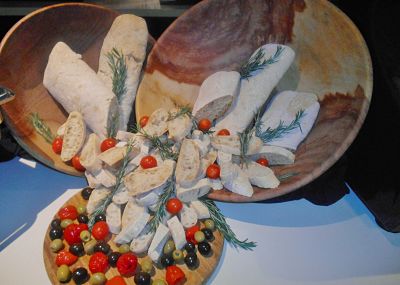
You are ready to host your best business conference yet! You’ve got the venue booked, the speakers confirmed and the goodie bags packed, but have you thought about the menu?
Most companies and their event planners underestimate the importance of the menu options at a business conference. The menu will often determine whether the conference is a success or not because the type of food you eat will affect the way you feel. If attendees at the business conference feel tired, sluggish or heavy, they will not be as alert as you want them to be and they will not experience the event as it was intended. What food we put into our body will directly affect what we get out of it. Along with the types of foods that are served, you also need to be mindful of the diets of the guests, the timing of the meals and the way that the meals are served.
Here are a few ideas to play around with when planning the menu for a business conference:
Cater for everyone:

you may not always be given a list of the dietary requirements for all the attendees so you need to make sure that there are options for everyone. When it comes to snack and tea time, be sure to have decaffeinated drinks, low fat, full cream and lactose-free milk. Fresh fruit juices and smoothies are great alternates for those who don’t drink tea and coffee. Don’t limit the snacks to nuts and biltong, some may be allergic to nuts and some may be vegetarian. Fruit is always a winner, but be sure to have a large variety as certain fruits may be too sweet for diabetics, some fruits may trigger an allergic reaction and some people’s diet plans may exclude fruit. Extend this ideology to all other meals as well.
Choose slow release carbohydrates:
It is common practice for people to look to sugar when energy levels are dropping but sugary foods are broken down quickly by the body, resulting in a burst of energy followed by a ‘crash’. This will end up making the attendees at the business conference grumpy and inattentive. Slow release carbohydrates keep you feeling fuller for longer because they’re broken down far more slowly. Asparagus, broccoli, sweet potato, quinoa, fruit, and oats are some of the options for slow release carbohydrates. If you want to maintain energy, satiation and engagement levels at your conference, be sure to plan your meals around these kinds of foods.
Serve oily fish:

Salmon, halibut, mackerel, and tuna contain essential fatty acids that can’t be produced by the body. The omega 3 in these fats contribute to good memory and concentration. Instead of wanting a nap after lunch, your attendee’s minds will be sharper than ever if you feed them this. If fish isn’t available, walnuts are an alternative as they are also rich in omega 3.
Create nutritionally balanced meals:

Meal prepared for a conference at Umthunzi
Having a nutritionally balanced meal means that you are getting everything you need from your food but not overdoing the calorie intake. It also means that you don’t have to deprive yourself of anything. Your meals for the day should include carbohydrates, protein, starch, a bit of fat, fibre and some fruit and veggies. Serving portions need to be considered as well. A nutritionally balanced meal has been scientifically proven to increase productivity and to reduce stress.
Fuss free eating:
Some companies and venues serve full, sit-down meals, which are much easier as the attendees are seated, have cutlery sets at their disposal and are able to eat almost anything, comfortably. Informal, standing or outdoor meals can be a bit more tricky. The meals need to be served in small, sturdy and easy to hold, throwaway dishes. Using throwaway dishes is preferable as then the attendees don’t have to wait for someone to come and pick up dishes, or look for a spot where they can leave them. Be sure to serve the dishes with the appropriate cutlery and serviettes. If you are serving meat, fish or anything else that is more than a mouthful, make sure that it is cut into bite size chunks and easy to eat. It is a bit difficult to cut food up if you are standing and eating. Serve dishes that don’t require any condiments and that can be eaten without any additional food; for example, don’t serve a curry as one would need rice or bread to eat with it. Be mindful of foods that have strong smells and flavours that could linger, like garlic, eggs, and onions. When deciding on a meal, ask yourself these 3 questions; can it be served in a presentable and easy to eat manner? Is it easy and hassle free to eat? Can it be eaten easily on the go, standing or without a table?
Preparation:
All meals should be prepared in a way which the nutrients aren’t lost and in a way that is healthy. Stir-frying, steaming, boiling and grilling are some of the healthiest cooking methods.
Water:

This is an obvious but essential one. Make sure that attendees have enough water throughout the day. Water should be chilled and served in glasses or glass bottles. There should be an urn available for those who drink hot water. It is common for an air-conditioner to be on at a business conference and this dehydrates the crowd, which is why it is even more important for them to increase their water intake.
Potential menus:
Here is a potential breakfast, lunch and snack menu for you to use as a guideline:
- Breakfast menu: oats, muesli and yogurt (low-fat option should be available), freshly squeezed juices, water, hot beverages, a wide variety of fruit, healthy muffins and whole grain bagels.
- Lunch menu: salad, mushroom risotto, vegetable stir fry, fish or chicken white meat, sweet potato and halloumi wraps.
- Snack menu: an assortment of nuts, cheeses, fruit skewers, whole wheat crackers and rice cakes. Juices and hot beverages.
We are certain that if you follow the tips above, the return on investment on the menu choice will reflect positively in the output of your business conference.
CONFERENCE SPECIALS
Conferences / Team Building



